FINE ANTIQUE JAPANESE BASKET Bamboo Hanakago Tea Ceremony Vase Chado Ikebana
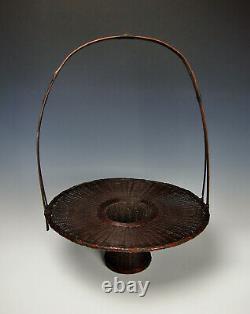
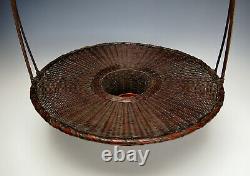

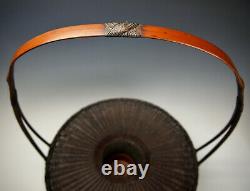
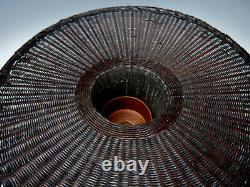
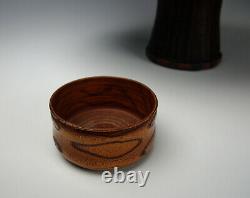
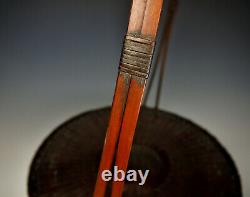

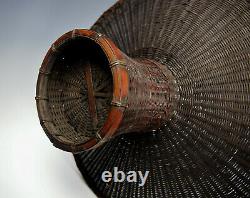



FINELY HAND CRAFTED ANTIQUE JAPANESE IKEBANA BASKET. Meiji / Taisho Period (early 1900s). Exquisite antique hand crafted basket for chabana (flower arrangement in a tea room). Originally used in the tokonoma alcove during the Japanese tea ceremony, this superb hand woven basket exhibits a tasteful presence. Very rare form with a wonderful wide brim which sets off the botanical arrangement in dramatic fashion.
The dark, smoked bamboo patina is absolutely sublime, and the handle lends a feeling of gentle cultivation. The epitome of the Japanese naturalist aesthetic, with a subtle nod to the wide brimmed Yangban Korean hats of the Joseon period known as gat. Hanaire, containers for flowers, traditionally are chosen to compliment the flowers representing the season or mood that the tea master desires to present.
This sublime hanakago basket makes a superb sculptural display in its own right, or would be exquisite with a natural arrangement of cultivated flowers and grasses. For use with water, a small cup is be inserted. There is a lovely wooden one included with a small chip on the rim, very wabi sabi.
The basket is of significant size, measuring approximately 14.5 inches wide and 21 inches high. Would make an outstanding addition for the collector of Japanese antiques and tea related accoutrements.See 11 photos above left. Wabi-sabi is the quintessential Japanese aesthetic. It is a beauty of things imperfect, impermanent, and incomplete. It is a beauty of things modest and humble. It is a beauty of things unconventional...
It is also two separate words, with related but different meanings. "Wabi" is the kind of perfect beauty that is seemingly-paradoxically caused by just the right kind of imperfection, such as an asymmetry in a ceramic bowl which reflects the handmade craftsmanship, as opposed to another bowl which is perfect, but soul-less and machine-made. "Sabi" is the kind of beauty that can come only with age, such as chips, wear, or the subtle antique patina.
It can also refer to quirks and anomalies arising from the process of construction, which add uniqueness and elegance to the object. Sabi is beauty or serenity that comes with age, when the life of the object and its impermanence are evidenced in its patina and wear, or in any visible repairs. In one sense wabi-sabi is a training whereby the student of wabi-sabi learns to find the most simple objects interesting, fascinating and beautiful. Fading autumn leaves would be an example.
Wabi-sabi can change our perception of the world to the extent that a chip or crack in a vase makes it more interesting and gives the object greater meditative value. Similarly materials that age such as bare wood, paper and fabric become more interesting as they exhibit changes that can be observed over time. VIEW OUR OTHER ANTIQUE TREASURES & OFFERINGS HERE. We have many wonderful Asian antiques listed this week including Satsuma, Inro, Netsuke, Bronze, Kutani, Jade, Baskets, Lacquer, Pottery, Chado Tea Ceremony items, Woodblock Prints, Cinnabar Lacquer, Famille Rose, and more from the Ming, Qing, Edo, and Meiji Periods.
Professionally Packed Ships to United States and select International regions. We have been in the antique business for over 35 years, and highly value our customers. Satisfaction Guarantee: All items are carefully described and photographed. The items listed are antiques, and as such may have an expected amount of wear from normal use. We do not sell items with major flaws without mentioning it in the listing.Please note that cause for return does not include barely noticeable minor wear commensurate with age or slight color variations from different computer monitors. The item "FINE ANTIQUE JAPANESE BASKET Bamboo Hanakago Tea Ceremony Vase Chado Ikebana" is in sale since Monday, November 8, 2021. This item is in the category "Antiques\Asian Antiques\Japan\Other Japanese Antiques". The seller is "flowerheartsmile" and is located in Bellevue, Washington.
This item can be shipped worldwide.
- Featured Refinements: Tea Ceremony
- Region of Origin: Japan
- Type: Baskets
- Age: 1900-1940
- Primary Material: Bamboo
- Original/Reproduction: Antique Original
- Color: Brown

